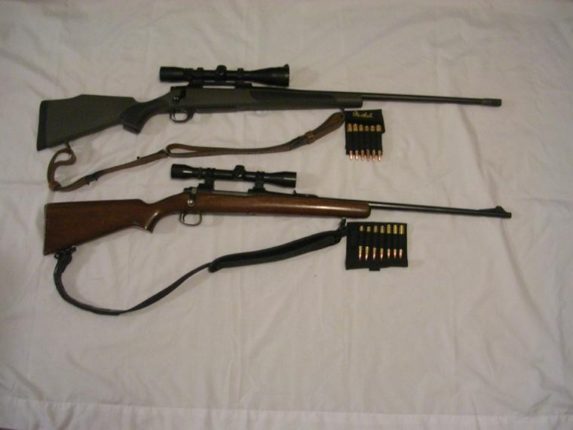Long-range hunting is attracting more and more people each year. I’m not talking about shooting deer or elk at anywhere near 1,000 yards. I wanted to discuss mistakes hunters make out to 500 or 600 yards
Truthfully, the maximum effective range, or the distance at which a hunter can consistently place shots in the vital zone, varies with each hunter, even when the equipment is similar.
Despite what some people will tell you, you can’t buy your way into making accurate shots from 500 to 700 yards. Making shots at that distance requires more than buying the top-of-the-line rifle from Remington, Winchester, Weatherby, Savage, Holland and Holland, Merkle, or any other brand you prefer. It takes skill.
Consider wind drift on a Remington Core-Lokt, .30-06, 180-grain bullet with a muzzle velocity of 2,650 feet per second, and a ballistic coefficient of .452. At 200 yards, the wind drift on that bullet in a 10 mph crosswind would be under 3 inches. Probably not enough to take you out of the vital zone. But if you don’t account for that wind drift at 600 yards, the bullet will have moved almost 30 inches. Well out of the kill zone.
Flinch can move the shot off by 10 inches, and something as unnoticeable as an angled trigger pull can make what would have still been a lethal shot at 300 yards into an all day tracking job at 600 yards.
Fortunately, rifles, optics, range finders and ammo are better than they were 20 or 30 years ago, but the hunter must do his part by developing the skill to keep the rifle as still as possible while getting the shot off.
Many shooting instructors tell their students to concentrate on the front sight or crosshairs of a telescopic sight and squeeze until the trigger breaks and the shot surprises them. That is the standard advice for target shooters, but it amounts to a negligent discharge. If you are a hunter, you need to be able to get the shot off when you want it to go off without moving the sights off target or your opportunity may be lost.
What do you focus on when you have a game animal in your sights? Most people if they answered that question truthfully would say the target. You can only focus on one thing at a time over distance so you should focus on the front sight or the crosshairs in a telescopic sight.
By focusing on the front sight or crosshairs, you can more easily see how much your rifle is moving and can tame it by adjusting your position and letting the front sight or crosshairs rest right on or a little above the vital area, where you want them to rest with minimal movement.
There is also an idea among many that a fast second shot begins with pulling the bolt back quickly and forcefully, ejecting the spent cartridge case and shoving the bolt forward picking up a new cartridge, loading it into the chamber and locking the bolt down behind it. Such a forceful cycling of the bolt is a mistake because it moves the rifle off target and forces the shooter to re-position his face and upper body. Instead, the bolt should be pulled back and pushed forward smoothly without disrupting body position or sight picture. You will find that it is actually faster than being in a hurry.
Breath control is vital to good long range accuracy, but only if you know how to hold your breath properly. You should inhale and exhale thoroughly, then cease exhaling as you see the crosshairs settling down, centered on the target. If you can’t make the shot in 5 to 10 seconds, the time you start to shift your focus because of a lack of oxygen, you need to break off the target, breath again, regroup and refocus.
Serious long-range hunters need to pay strict attention to their scope mount. In many cases, scopes are simply dropped in the rings, screwed down tight, and that is it. For shots at 100 to 150 yards that might not be a problem. However, if you are taking shots at 500 to 600 yards and sometimes more you need to be absolutely sure your scope is leveled with the action. This doesn’t take much time, a simple plumb line with a weight attached will work, but there are companies that make inexpensive scope leveling devices that fit in your pocket.
There are many hunters that believe that the solution to any problem is better equipment. Admittedly I am an advocate of the best equipment I can afford. My choice for a long-range hunting rifle from the time I was in my mid-teens has been a .300 Weatherby Magnum, normally with 180-grain or 220-grain Spire Point with boat tail bullets, with a ballistic coefficient of .425 and .481 respectively. My back-up rifle for long range shooting is an old Remington Model 721 in .30-06 with the previously mentioned 180 grain Core-Lokt bullet with a ballistic coefficient of .425.
However, the equipment that any of us buy, no matter whether top of the line or simply very good equipment, is handicapped by the ability of the shooter.
I think what I have discussed here are the first things we all must work on to have success in long-range hunting. There are great rifles, better optics than before, flatter shooting cartridges, even flatter than the .300 Weatherby if one really wants to go with the newer .30-378 Weatherby Magnum. But the reality is that we are our own worst handicap when it comes to long-range hunting. Our ability as riflemen can make top of the line equipment look pretty bad, or an old Remington Model 721, .30-06 built in the late 1940s seem like the greatest rifle ever built.
Smokey Merkley was raised in Idaho and has been hunting since he was 10 years old. He can be contacted at mokeydo41245@hotmail.com.

